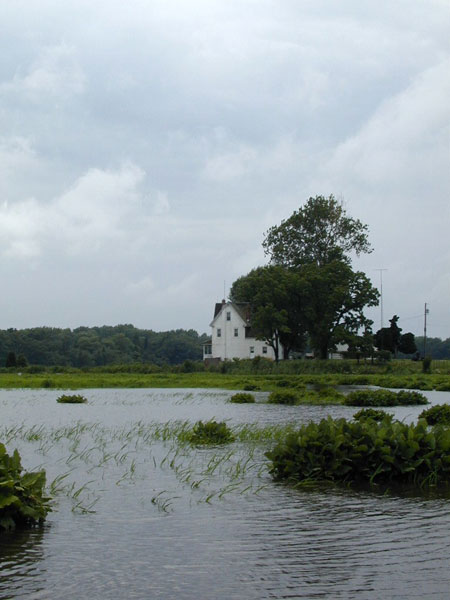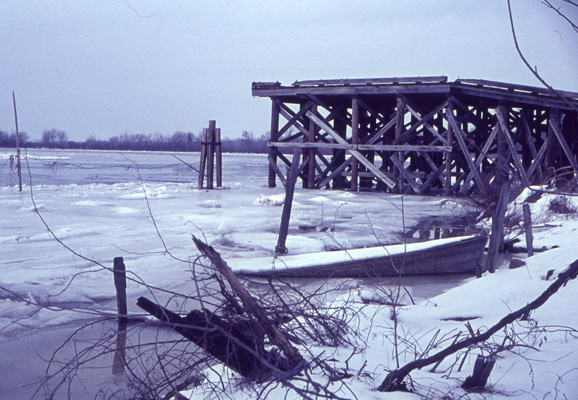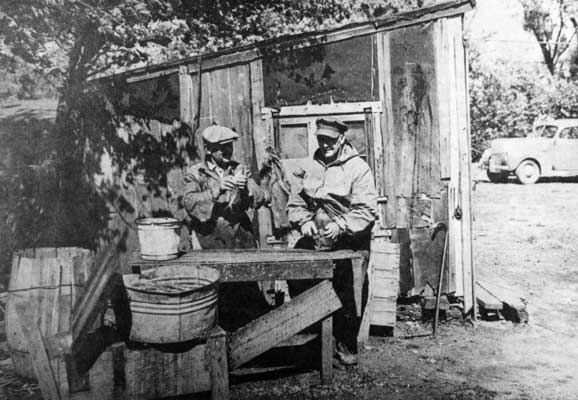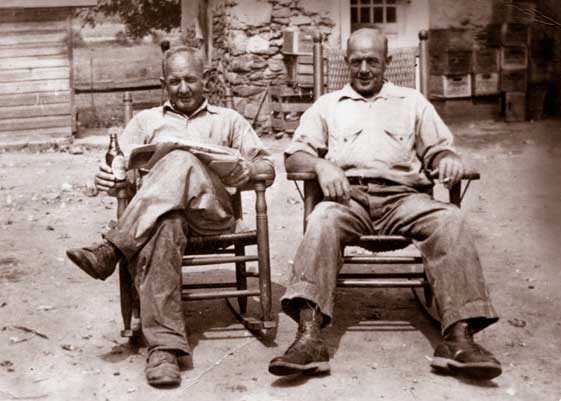 The Burcham Farm is an icon - the last diked farm on the Maurice River. There has been much written about the family and the property. What hasn't been written is the end of the story, and that is something that the property owners, Janice and Jeanette Burcham, hope will never come to pass.
The preservation of this historic 99-acre property was on their minds as the twins approached their upper years. The Burcham twins have attracted attention and have gained recognition for their work to preserve the farm. In 1989 they were the recipients of the NJ Agricultural Society's Century Farm Award. Since 1951, the twins have been instrumental in maintaining the family's legacy. Without the wall of "rubble" they continually bolster, the Maurice River will reclaim the land that lies below the water level. (see sluice gate used to drain farm of water after storm events) The family home where they live, with the very bed where they were born, is perched higher up, but around the hill, the river encroaches.
The Burcham house was given its final renovation in 1907. According to the research of Patricia Bovers Ball (1995) "the earliest identified farmhouse building on the Burcham property was a one-room, hall-plan structure that stood at the north end of the existing house. Its small size and high pitched roof suggest an 18th century date of construction." Bovers Ball reported that new sections were added to the building over the decades, but this original section of the structure was demolished in 1961. The date of the first addition came sometime in the mid-1900's, but there is no firm date about this. The addition was a 1 1/2 story with a gable roof structure and a western façade. Bovers Ball describes the last major additon to the house, built in 1907. "It consisted of a new southern front - a brick Gothic Revival building. The new addition was a 2 1/2 story brick building that still stands. "The twins were born, five minutes apart, in November 1925 to Frank A. and Maud Burcham. They have been interviewed by journalists, researchers, and the curious. Janice and Jeanette admitted that at this point they felt like robots, mechanically reciting the facts about their farm and the brickmaking business that was carried out there:
- In the morning workers would "dig the clay" and fill coal cars.
- A boiler-powered cable line pulled the coal car over the pit; The clay was dumped; The cart returned by gravity to the clay pits.
- After grounding the clay, it was packed into moulds to be shaped. Lengths of bricks were cut by a wire - 8 to a pallet -5 pallets high -which were sent to the drying shed.
- There were three grades of brick: commons, red hards, and salmons.
- Once dried thoroughly, the bricks were wheeled up to the kiln, where the wood-fed "fire box" was burning round the clock during the production period.
- At the height of the Burcham's brick operation, 15,000 bricks were produced weekly. Horse-pulled wagons carried the final product to buyers - except on one occasion when a barge carried away one load. That one shipment carried 70,000 bricks. The deal was not handled satisfactorily and no further shipments left on the barge.
- The brickyard ceased operation in 1942.
These details that the twins provided have been well documented, but there are some lesser-known tidbits that they shared. During the summers,efforts were directed to the brick making process, but after the first frost, when the clay was too hard to dig, the workers spent their time cutting the wood needed to fire the bricks. The Burchams owned a wooded tract of land along Delsea Drive. The wood on that property was cut by hand and then lined up along the lane that leads to the house.
The "bomb shelters" that serve as storage sheds on the property were erected on the site of the brickyard. They are actually halves of fuel storage tanks.
The twins shared some other lesser-known facts about the farm that lies between the Maurice River and Delsea Drive (Route 47): The "Horseshoe Bend" of the Menantico Creek is right across from the Burchams’ mailbox. The road leading to the farmhouse has always been called "the lane."
There are some misconceptions that they offered to clear up:
- The Burchams never grew salt hay.
- Theirs was not a truck farm; the vegetables fed the family and the laborers.
- It is costly to maintain the dike. The concrete, gravel and clam shells have been donated, but the laborers need to be paid.
- It would take only a few Nor'easterns or the wake of fast boats to wipe out all their work.
Chickens have always provided the Burchams with "egg money." There are no more horses on the farm. Long ago they were used for hauling the bricks. The Burchams do keep sheep, to the delight of the school children when they come to visit the farm on their class trips.
 It hasn't been easy to hold onto history. The stories about "what was" are fast-fading memories: In 1935, Clarence Wolf of NJ Silica leased the land and riparian rights from Frank Burcham. Wolf constructed a commercial pier to transport NJ Silica's sand on the Maurice River rather than pay the increasing cost that the railroads were demanding. The sand company used the wharf only once, but that was enough to convince the railroad to roll back their rates. "Wolfie's Wharf" was demolished in 1994. Who will remember that? It hasn't been easy to hold onto history. The stories about "what was" are fast-fading memories: In 1935, Clarence Wolf of NJ Silica leased the land and riparian rights from Frank Burcham. Wolf constructed a commercial pier to transport NJ Silica's sand on the Maurice River rather than pay the increasing cost that the railroads were demanding. The sand company used the wharf only once, but that was enough to convince the railroad to roll back their rates. "Wolfie's Wharf" was demolished in 1994. Who will remember that?
Janice and Jeanette's swimming hole was their favorite place when they were growing up. It was relocated when Wolf leased that slice of the family property - and the riparian rights, for his wharf. Who will remember seeing the young twins frolicking at the river's edge - or tell the stories about their encounters with the occasional otter that drifted up river?
 Two fishermen connected with this spot on the Maurice River were Toots Peterson and Joe Touser. Who will remember the two colorful characters whose fish stories and other tales entertained the locals? Two fishermen connected with this spot on the Maurice River were Toots Peterson and Joe Touser. Who will remember the two colorful characters whose fish stories and other tales entertained the locals?
Janice and Jeanette did not plan to gather so many memories of their family farm. They never expected to live out their lives on the family property. Their parents had aspirations for them and saw that they finished their four years at Millville High and continued on to college. The twins said that they were fortunate to have that opportunity and they looked forward to it.
Still, college was the first time the twin sisters were separated. They acknowledged the detrimental effect it had on both of them during their first months apart. They both recalled how they lost weight and agreed that they both experienced a real sense of loss. They remembered that they were so affected by the separation that their college counselors recommended that they build time in their busy college schedules to visit each other.
After that realization, they spent the time between their studies visiting each other.
Jeanette was at NJ's Montclair University while Janice went to a nursing school in Livingston, NJ. In her freshman year Janice joined the Cadet Corps (a government nursing corps). Without a second thought, Janice shared her monthly salary - $15 - with her sister, Jeanette said.
The obligation to serve in military hospitals was rescinded by the time Janice graduated, but she enlisted in the Navy anyway. During that time, she earned a bachelor's degree from University of Oregon and a master's degree from the Columbia University. She served in the Navy for 27 years, earning much recognition, including a Navy Commendation Medal. When she returned to Millville in 1975, she was offered the opportunity to be director of nursing at Cumberland County Hospital, which she declined.
By the time Janice enlisted, Jeanette had secured a teaching position in the state of Washington. In 1948, she was offered a job at an American school in Egypt. The school was established by the State Department for the children of American citizens who were working abroad, and for the children of foreign diplomats. Jeanette was excited by the opportunity and moved to the Middle East to teach American History, European History, and Problems in American Democracy to her 7 to 12th grade students. She also taught physical education.
Jeanette returned to the farm in 1951 to care for her mother. After her mother's death, Jeanette attended the University of Pennsylvania, earning her masters degree. She also studied transportation law at the Academy of Advanced Traffic and practiced transportation law in the federal courts before the Interstate Commerce Commission. While helping to maintain the farm, she also worked at her brother's trucking firm.
In this interview (October 2004), the Burcham twins quickly moved through the history of their education and careers to a less-talked about period in their lives - their high school years and their athletic endeavors.
Both played basketball in a church intramural program. "Jeanette was the star," said Janice with pride. Jeanette dismissed that comment and steered the conversation to their team, which earned the title, "Millville regional champs." They both delighted in recalling how many local teams their team put down in tournaments. During one memorable season, an outside group, an "RCA team," was invited to participate in one of the tournaments, "to provide some competition," the twins chuckled. They remembered that tournament well. "These weren't students. They played full-court, They played like men." The twins thoroughly relished the memory.
 When Maud Jones Burcham, passed away in 1951, Janice and Jeanette had some decisions to make. Their father had died in 1948. The two Burcham brothers, Russell and Melvin, were not interested in living on the family property so their parents left the land to their twin daughters. Janice decided to continue her career in the Navy, looking forward to a retirement with a pension. An uncle, George Hessler, came to run the farm for them. Jeanette related that, although she wanted to go to Turkey to teach, she came home and took a job with her brother's trucking firm. "I wound up running the office for 33 years," she said. Uncle George, who once had a dairy farm in the Philadelphia area, stayed on to tend the farm. When Maud Jones Burcham, passed away in 1951, Janice and Jeanette had some decisions to make. Their father had died in 1948. The two Burcham brothers, Russell and Melvin, were not interested in living on the family property so their parents left the land to their twin daughters. Janice decided to continue her career in the Navy, looking forward to a retirement with a pension. An uncle, George Hessler, came to run the farm for them. Jeanette related that, although she wanted to go to Turkey to teach, she came home and took a job with her brother's trucking firm. "I wound up running the office for 33 years," she said. Uncle George, who once had a dairy farm in the Philadelphia area, stayed on to tend the farm.
Decades slipped away. Their worldly travels became another memory as the Burcham sisters occupied themselves with the daily upkeep of the family property. It was home - it is history. Future generations will be fortunate if preservation efforts can protect the legacy that the Burcham twins worked a lifetime to hold onto.
|
 click to navigate the map "up".
click to navigate the map "up". click to navigate the map "down".
click to navigate the map "down". click to navigate the map "left".
click to navigate the map "left". click to navigate the map "right".
click to navigate the map "right". click to "zoom in" for a closer look.
click to "zoom in" for a closer look. click to "zoom out" to back away from the map.
click to "zoom out" to back away from the map. click to get back to the "default" map setting.
click to get back to the "default" map setting. click to learn more about that reach.
click to learn more about that reach.


